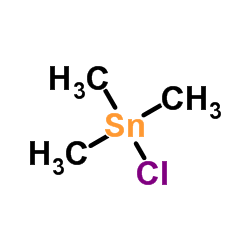Trimethyltin chloride

Trimethyltin chloride structure
|
Common Name | Trimethyltin chloride | ||
|---|---|---|---|---|
| CAS Number | 1066-45-1 | Molecular Weight | 199.267 | |
| Density | 0.988 g/mL at 25 °C | Boiling Point | 95.8±23.0 °C at 760 mmHg | |
| Molecular Formula | C3H9ClSn | Melting Point | 37-39 °C(lit.) | |
| MSDS | Chinese USA | Flash Point | 11.8±22.6 °C | |
| Symbol |


GHS06, GHS09 |
Signal Word | Danger | |
|
Adsorption and degradation processes of tributyltin and trimethyltin in landfill leachates treated with iron nanoparticles.
Environ. Res. 142 , 511-21, (2015) Biotic and abiotic degradation of toxic organotin compounds (OTCs) in landfill leachates is usually not complete. In this work adsorption and degradation processes of tributyltin (TBT) and trimethyltin (TMeT) in leachate sample treated with different iron nan... |
|
|
Synthesis, characterization and biocidal activity of new organotin complexes of 2-(3-oxocyclohex-1-enyl)benzoic acid.
Eur. J. Med. Chem. 45 , 883-9, (2010) The reaction of 1,3-cyclohexadione with 2-aminobenzoic acid has produced the 2-(3-oxocyclohex-1-enyl)benzoic acid (HOBz). Subsequent reactions of the ligand with organotin chlorides led to [Me(2)Sn(OBz)O](2) (1), [Bu(2)Sn(OBz)O](2) (2), [Ph(2)Sn(OBz)O](2) (3)... |
|
|
Trimethyltin-Induced Microglial Activation via NADPH Oxidase and MAPKs Pathway in BV-2 Microglial Cells.
Mediators Inflamm. 2015 , 729509, (2015) Trimethyltin (TMT) is known as a potent neurotoxicant that causes neuronal cell death and neuroinflammation, particularly in the hippocampus. Microglial activation is one of the prominent pathological features of TMT neurotoxicity. Nevertheless, it remains un... |
|
|
The selective norepinephrine reuptake inhibitor atomoxetine counteracts behavioral impairments in trimethyltin-intoxicated rats.
Eur. J. Pharmacol. 683(1-3) , 148-54, (2012) This study was carried out to assess the behavioral effects of the non-psychostimulant drug atomoxetine, in rats prenatally-exposed to the organic compound trimethyltin chloride (TMT) and in spontaneously hypertensive rat (SHR), two rodent models of Attention... |
|
|
Blockade of glutamatergic and GABAergic receptor channels by trimethyltin chloride.
Br. J. Pharmacol. 144(2) , 283-92, (2005) 1. Organotin compounds such as trimethyltin chloride (TMT) are among the most toxic of the organometallics. As their main target for toxicity is the central nervous system, the aim of the present study was to investigate the effects of TMT on receptor channel... |
|
|
Mechanism underlying hypokalemia induced by trimethyltin chloride: Inhibition of H+/K+-ATPase in renal intercalated cells
Toxicology 271(1-2) , 45-50, (2010) Trimethyltin chloride (TMT), a byproduct of plastic stabilizers, has caused 67 poisoning accidents in the world; more than 98% (1814/1849) of the affected patients since 1998 have been in China. As a long-established toxic chemical, TMT severely affects the l... |
|
|
Endogenous and exogenous glucocorticoids prevent trimethyltin from causing neuronal degeneration of the mouse brain in vivo: involvement of oxidative stress pathways.
J. Pharmacol. Sci. 110(4) , 424-36, (2009) The organotin trimethyltin (TMT) is known to cause neuronal degeneration in the murine brain. Earlier studies indicate that TMT-induced neuronal degeneration is enhanced by adrenalectomy. However, no evaluation has been attempted to determine the mechanism un... |
|
|
Regeneration of granule neurons after lesioning of hippocampal dentate gyrus: evaluation using adult mice treated with trimethyltin chloride as a model.
J. Neurosci. Res. 82(5) , 609-21, (2005) The hippocampal dentate gyrus in adult animals is known to contain neural progenitors that proliferate and differentiate into neurons in response to brain injury. Little has been observed, however, on regeneration of the granule cell layer of the dentate gyru... |
|
|
Ultraviolet degradation of methyltins: elucidating the mechanism by identification of a detected new intermediary product and investigating the kinetics at various environmental conditions.
Chemosphere 72(3) , 389-99, (2008) The photodegradation of methyltins, as environmental pollutants, has scarcely been studied so far because of the shortage of rapid and sensitive speciation methods, even though they have very simple structures. The photodegradation of monomethyltin trichlorid... |
|
|
In vivo acute treatment with trimethyltin chloride causes neuronal degeneration in the murine olfactory bulb and anterior olfactory nucleus by different cascades in each region.
J. Neurosci. Res. 86(7) , 1635-46, (2008) Our earlier study demonstrated that in vivo acute treatment with trimethyltin chloride (TMT) produces severe neuronal damage in the dentate gyrus and cognition impairment in mice. In the present study, we assessed whether TMT was capable of causing neuronal d... |